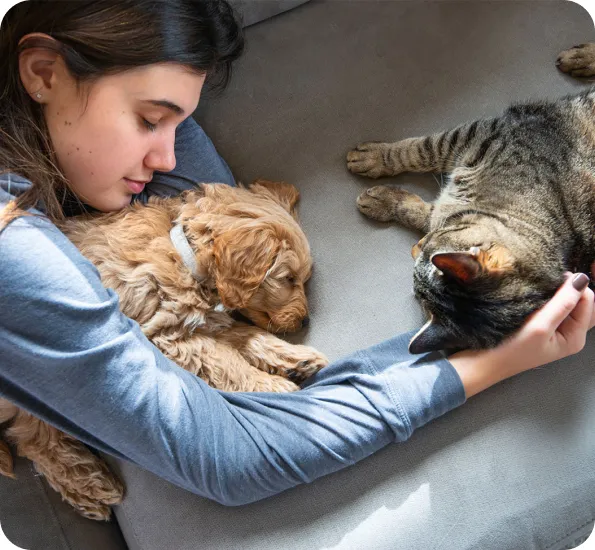Bond Study
Are all relationships the same?
No. There are two types of bond with animals: the emotional bond and the pragmatic bond. Let’s look at each one.
Emotional bond
This is a relationship where the emotional bond with the animal is very strong. For these people, their dog is a very significant source of emotional support, especially in difficult situations.
Pragmatic bond
In this type of relationship, the bond of love and support is not perceived in such a strong way. Living with an animal brings clear benefits, but the emotional dimension is not so intense.
What are the differences between emotional and pragmatic?
Let’s explore all the data, and discover the differences depending on how each of the filters is applied.
70% of people have an emotional bond.
30% of people have a pragmatic bond.
96%
They say that they cuddle their pet a lot
65%
82%
They think that taking care of their pet is an easy task
44%
88%
They say that their pet is always there when they need it
47%
37%
They think that it is not expensive to keep their pet
67%
62%
They say things to their pet that they would not say to anyone else
32%
84%
They say that their pet helps them deal with difficult times
41%
The Bond Study involves the analysis of the responses to a quiz comprising 32 questions, divided into three key blocks. The questions allow us to collect information that enables us to better understand how this interaction affects various aspects of people’s lives, the quality of their life together, the emotional wellbeing it generates and its impact on daily life.
Block 1
Interaction with the animal
In this block, aspects related to the frequency and quality of the interaction between the person and their animal are explored, as well as the shared activities that are part of their daily routine.
Block 2
Perceived emotional benefit
This block deals with how the emotional impact is perceived and addresses aspects such as stress reduction, improved mood and reinforcement of general wellbeing.
Block 3
Impact on quality of life
This block delves into the effects that the relationship with animals has on people’s quality of life and how living together improves physical and social aspects of daily life.

Let’s find out and analyse the responses on which the study is based
Each block is made up of many questions, and the responses can range from 1 to 5. Below, you can see the average results in each block, as well as the distribution of responses for each question.
Results of the study
Aggregate of 1827 responses
Rating from 1 to 5
Block 1
Interaction with the animal
In this block, the frequency and quality of the interaction between the person and their animal is analysed, as well as the daily activities they share.
How often do you kiss your pet?
(1 At least once a day - 5 Never)
How often do you play games with your pet?
(1 At least once a day - 5 Never)
How often do you buy your pet presents?
(1 Once a week - 5 Never)
How often do you give your pet food treats?
(1 At least once a day - 5 Never)
How often do you groom your pet?
(1 At least once a day - 5 Never)
How often do you cuddle your pet?
(1 At least once a day - 5 Never)
How often do you have your pet with you while relaxing?
(1 At least once a day - 5 Never)
Block 2
Perceived emotional benefit
This block focuses on how the emotional impact is perceived, addressing stress reduction, improved mood and general wellbeing.
My pet gives me a reason to get up in the morning
(1 Strongly agree - 5 Strongly disagree)
I wish my pet and I never had to be apart
(1 Strongly agree - 5 Strongly disagree)
My pet is constantly attentive to me
(1 Strongly agree - 5 Strongly disagree)
How often do you tell your pet things you don't tell anyone else?
(1 Once a day - 5 Never)
I would like to have my pet near me all the time
(1 Strongly agree - 5 Strongly disagree)
If everyone else left me, my pet would still be there for me
(1 Strongly agree - 5 Strongly disagree)
My pet helps me get through tough times
(1 Strongly agree - 5 Strongly disagree)
My pet provides me with constant companionship
(1 Strongly agree - 5 Strongly disagree)
My pet is there whenever I need to be comforted
(1 Strongly agree - 5 Strongly disagree)
How traumatic do you think it will be for you when your pet dies?
(1 Very traumatic - 5 Very untraumatic)
Block 3
Negative impact on quality of life
How living with an animal can, in some cases, negatively affect certain aspects of daily life.
How hard is to look after your pet
(1 Very hard - 5 Very easy)
There are major aspects of owning a pet I don't like
(1 Strongly agree - 5 Strongly disagree)
My pet makes too much mess
(1 Strongly agree - 5 Strongly disagree)
It bothers me that my pet stops me doing things I enjoyed before I owned it
(1 Strongly agree - 5 Strongly disagree)
It is annoying that sometimes I have to change my plans because of my pet
(1 Strongly agree - 5 Strongly disagree)
My pet costs too much money
(1 Strongly agree - 5 Strongly disagree)
How often do you feel that looking after your pet is a chore?
(1 Once a day - 5 Never)
How often does your pet stop you doing things you want to?
(1 Once a day - 5 Never)
How often do you feel that having a pet is more trouble than it is worth?
(1 Once a day - 5 Never)
Showing the data from 1827 interviews

